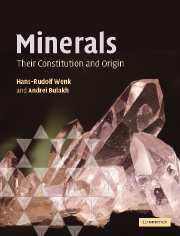Book contents
- Frontmatter
- Contents
- Preface
- Acknowledgments
- Figure credits
- Part I Structural features of minerals
- Part II Physical investigation of minerals
- Part III Variety of minerals and mineral-forming processes
- Part IV A systematic look at mineral groups
- Part V Applied mineralogy
- 30 Metalliferous mineral deposits
- 31 Gemstones
- 32 Cement minerals
- 33 Minerals and human health
- 34 Mineral composition of the solar system
- 35 Mineral composition of the earth
- Appendices
- Glossary
- References
- Index
- Plate section
- References
31 - Gemstones
from Part V - Applied mineralogy
- Frontmatter
- Contents
- Preface
- Acknowledgments
- Figure credits
- Part I Structural features of minerals
- Part II Physical investigation of minerals
- Part III Variety of minerals and mineral-forming processes
- Part IV A systematic look at mineral groups
- Part V Applied mineralogy
- 30 Metalliferous mineral deposits
- 31 Gemstones
- 32 Cement minerals
- 33 Minerals and human health
- 34 Mineral composition of the solar system
- 35 Mineral composition of the earth
- Appendices
- Glossary
- References
- Index
- Plate section
- References
Summary
Introduction
The first mineral you ever examined conscientiously was probably a gemstone, and gems are the objects that most people associate directly with minerals. Note that in many cases the names used for gems are different from those of the regular minerals that they represent. For example, ruby and sapphire are varieties of corundum, emerald and aquamarine are varieties of beryl, and alexandrite is a variety of chrysoberyl. In addition, the weight units used in gemology are different from those used in ordinary science. The most common weight unit is the carat, which corresponds to 0.2 g. Table 31.1 lists some of the important minerals that are used as gemstones.
Gemstones have been defined as minerals that are highly valued for their beauty, durability, and rarity; they may be worn for adornment or used to decorate art objects. Since they are rare, they have a high value. In fact the values of diamond, alexandrite, ruby, and emerald, the most precious gemstones, all exceed the value of gold (by weight unit) by a factor of about 3000 (Table 31.2).
Today many gems can be produced industrially, with properties similar to those of their natural counterparts. These artificial gems, however, sell at only a fraction of the price of the equivalent natural stones. Nevertheless, gem synthesis is a huge industry, both for jewelry manufacturing and industrial applications.
- Type
- Chapter
- Information
- MineralsTheir Constitution and Origin, pp. 532 - 549Publisher: Cambridge University PressPrint publication year: 2004



